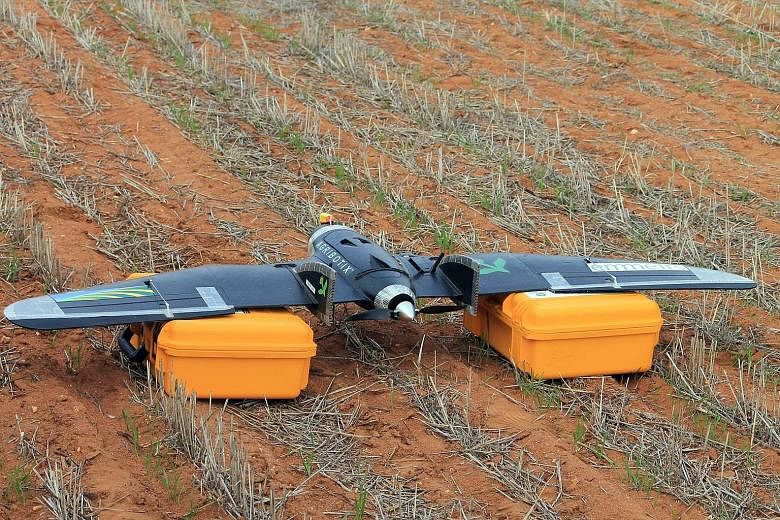For Australian farmers, basic tasks such as mustering cattle or inspecting crops no longer require hours on horseback or painstaking trips up and down distant fields.
The job is being revolutionised by the use of drones, or unmanned aerial vehicles (UAVs), which can do everything from rounding up cattle to irrigating fields, checking for damaged crops and lost herds, and monitoring breeding patterns.
"It's been very useful," said Mr Ross Johns, a third-generation wheat and barley farmer who has been hiring a drone service from a local provider.
"You can get a very clear picture of how the crop is performing. You can then try to lift the lower-performing crops to a higher level."
Aside from saving time, drones are helping to turn farming into an exact science and improving the quality and size of yields.
Mr Johns, 50, has a 6,600ha property in the state of Victoria. He used a local service to provide three drone flights to inspect and map crops last year and intends to conduct further flights this year.
He told The Straits Times the maps helped to show the health of different crops, which in turn allowed him to vary the type and amount of fertiliser and ultimately to produce more wheat and barley.
"You can do a ground inspection, but you don't get as good a grasp of the (health) differences of crops in different areas," he said.
Some experts believe drones are set to overhaul farming and will become more common as the price drops and the technology improves.
An engineer who has researched the use of drones, Dr Cheryl McCarthy, last year predicted that drones will become as common as tractors by 2025.
"They offer a big time and labour saving in doing the scouting operations," she told ABC News.
"Instead of going in by foot, (the farmer) can be deploying the drone. It can be... collecting images and automatically interpreting where there are unhealthy areas in the paddock, or where there are weed outbreaks, and presenting that information in real time to the farmer."
Australia has about 135,000 farm businesses, which are expected to help produce about A$60 billion (S$61 billion) worth of exports this year. The biggest rural exports include beef and veal, live cattle, wool, cotton, milk as well as crops such as wheat, barley and other grains.
It is believed that only a small fraction - perhaps 5 per cent - of the nation's farmers are currently using the technology, though many of these are owners of larger farms. But the use is likely to increase soon with the introduction of new aviation rules which will make it easier for private farmers to fly drones on their properties.
Australia's Civil Aviation Safety Authority (Casa) said in a statement on April 1 that it plans to allow farmers to fly remotely-piloted drones weighing up to 25kg over their property without an operating certificate.
The changes are due to start from September.
"That's a drone that can take a pretty good payload, could carry a fair bit of chemical around for crop spraying, could easily carry cameras and other gear to do visual inspections," Casa spokesman Peter Gibson told ABC News.
An expert on drones, Mr Will Bignell, from a Tasmanian-based firm called DroneAg, said the most significant change for farmers will not be avoiding basic chores but having more accurate crop data.
"Data quality, data understanding and data manipulation is where a drone business comes into play, as opposed to just 'drones in agriculture', which usually means a farmer using an off-the-shelf drone to fly around herding sheep or looking for stuck cows, checking the back block and just general scouting," he told The Australian Financial Review last month.
Drone mapping can be used by farmers to make decisions such as whether to re-sow crops or use sprays to combat pests and insects.
Mr Matt Burns, from Emmetts John Deere machinery, a Victoria- based firm which operates drones, said the machines can cover from 450ha to 1,000ha a day. The charge is about A$5 per ha.
Mr Burns said farmers often do not need to cover an entire farm but can focus on particular fields.
"We're using the cameras to get a whole snapshot of how the field is performing," he told The Straits Times. "Farmers can reduce input costs (such as fertilisers, chemicals, re-seeding costs) - it can be a very quick return."
But some farmers in Australia have discovered one persistent obstacle: the drones are often attacked by wedge-tail eagles, a large bird of prey found across the country. During mating season, operators have had to land drones after realising they were being angrily pursued by eagles.
"You have to be very careful," Mr Burns said.
"We have been attacked a couple of times and followed a few times. So far we have not lost a UAV - but it definitely makes you nervous."

